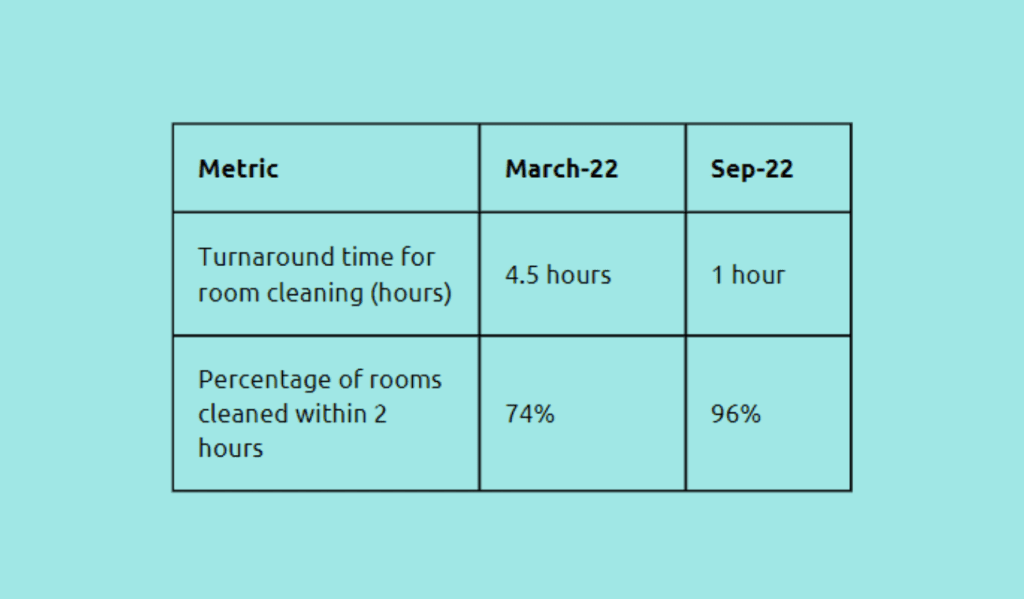Streamlining Inpatient Bed Management: A Process Innovation Case Study
Read the Magazine in PDF
Abstract:
This case study focuses on the process innovation implemented at P.D. Hinduja Hospital & Medical Research Center to enhance inpatient bed management. The hospital faced challenges related to bed availability, timely admissions, and coordination among various departments. The hospital aimed to improve patient care, reduce delays, and enhance patient experience by addressing these issues and implementing practical solutions. The innovation involved technology, real-time tracking systems, and improved communication channels. The results showed significant improvements in turnaround time for room cleaning and the percentage of rooms cleaned within the defined time frame.
Organization Profile
P.D. Hinduja Hospital & Medical Research Centre, a part of the Hinduja Group, started as a clinic in 1951 and has now evolved into one of India’s top multi-speciality tertiary care hospitals. The hospital has two units, one in Mahim with 400 beds and the other in Khar with 100 beds, both are equipped with state-of-the-art infrastructure and staffed with nationally and internationally recognized doctors. P.D. Hinduja Hospital, Mahim, has always been at the forefront of adopting technology in healthcare delivery and has incorporated advanced medical technologies such as the Gamma Knife, broadband MRI with ambient themes, a True Beam Linear Accelerator, and a fully integrated robotics system. The hospital has also been accredited and certified by NABH, CAP, and ISO, with quality care as its primary focus. P.D. Hinduja Hospital has consistently won numerous awards for being the best multi-speciality hospital, ranking as the top hospital in western India in the Newsweek World’s Best Hospital Survey 2020 and 2021. The hospital also offers free or concessional treatment to those in need and runs the Serve with Passion rural health program, which provides free healthcare services to tribal areas in Maharashtra. In addition, the hospital partners with leading international institutes, including the Division of AIDS (NIAID, NIH), U.S.A., to establish a centre of excellence for infectious disease research in India.
Introduction:
P.D. Hinduja Hospital is a tertiary care facility with 400 beds and consistently high occupancy rates of over 90%. The hospital regularly has a waitlist of patients requiring prompt access to beds, and in addition to scheduled admissions, it receives multiple emergency admissions. Feedback from patients and consultants has highlighted concerns regarding bed management, as delays or refusals in bed availability can impact patient care and harm the hospital’s reputation. To address this issue, a team of employees has thoroughly studied the matter and is working on developing effective solutions.
Effective bed management involves coordination among teams, such as nursing, floor coordinators, housekeeping, admissions, and patients. However, as these teams have multiple responsibilities, manual tracking of patient discharge, room transfer, and housekeeping cleaning was often incomplete.
To address the bed management issues, a Quality Circle team was formed with representatives from various departments, including Housekeeping, Inpatient floors, admissions, Customer service, Information technology department, Engg dept, Nursing and Laundry. The QC champion guided the team Head of Inpatient Services and Quality team. They used a cause and effect diagram to identify ten leading causes of bed management issues, which included:
- The bed availability tracking process was entirely manual, leading to issues in tracking bed availability from the discharge of one patient to the next patient’s occupation.
- Similar bed management issues were observed for patients transferred from one location to another.
- There was a need for alerts to be sent to the respective stakeholders in case a sub-process took more time than expected so that timely actions could be taken.
- Bed availability intimation to patients was manual, and the staff spent a lot of time on it as some phones went unanswered.
- The nursing staff was depended upon to check the rooms instead of the housekeeping and engineering team, leading to delays as they were busy with patient care activities.
- Discharge time tracking to the new patient occupation of beds was not done efficiently.
- Most admissions take place after 6 pm, stretching till 11 pm, leading to delayed preoperative preparation of patients or prolonged stay of patients in the minor casualty ward, causing inconvenience and distress to their relatives.
- Nurses often complained about the time spent coordinating with housekeeping, engineering, and admission departments, leading to patients reaching the ward when the bed was not ready.
The solution to the problem can be found in two phases:
Phase 1
- It implemented a discharge tracker to monitor patient discharge time until bill settlement and expanded it to track until the patient physically leaves the room.
- Housekeeping and Engineering shift supervisors were informed of the patient’s departure via SMS.
- Ward staff was responsible for updating the tracker in real time.
Phase 2
- It included all internal transfer cases, and a dashboard view screen was developed to take physical discharge time as input for housekeeping and engineering to enter room cleaning/clearance time.
- The dashboard provides real-time TAT information for each department.
- Housekeeping and engineering physically inspect the room before it is allotted to the next patient.
- The supervisor responsible for giving clearance ensures rooms are better prepared.
- Floor staff receive SMS alerts when HK clearance is done for a particular room and bedmaking is done.
- Alerts were developed to notify various stakeholders, including the HK Manager if room cleaning time exceeded defined benchmarks and the Engineering Manager if clearance was delayed.
To ensure that the improvements made are locked in for an extended period, the managers maintain a daily check to ensure that the turnaround time (TAT) is within the defined limits. Monthly analysis is conducted for cases where the TAT is higher than expected.
After successfully implementing the process innovation at our Mahim unit, we plan to replicate it at our Khar unit. We have found that escalations have helped maintain the TAT, so we will also use a similar approach for the Khar unit’s discharge process.
Outcome:
Significant improvements were made in room cleaning efficiency starting in September 2022. The percentage of rooms cleaned within the specified time frame also improved significantly.

Ensuring timely bed availability and admission is crucial for initiating treatment promptly.

Conclusion :
The process innovation implemented at P.D. Hinduja Hospital has successfully addressed bed management challenges and improved patient care. By streamlining processes, leveraging technology, and enhancing coordination among departments, the hospital significantly reduced turnaround time for room cleaning and increased the percentage of rooms cleaned within the defined timeframe. These improvements have positively impacted patient comfort, timely treatment initiation, and the overall patient experience. The success of the innovation at the Mahim unit has laid the foundation for replicating the same improvements at the Khar unit, ensuring consistent and efficient bed management across both departments.




